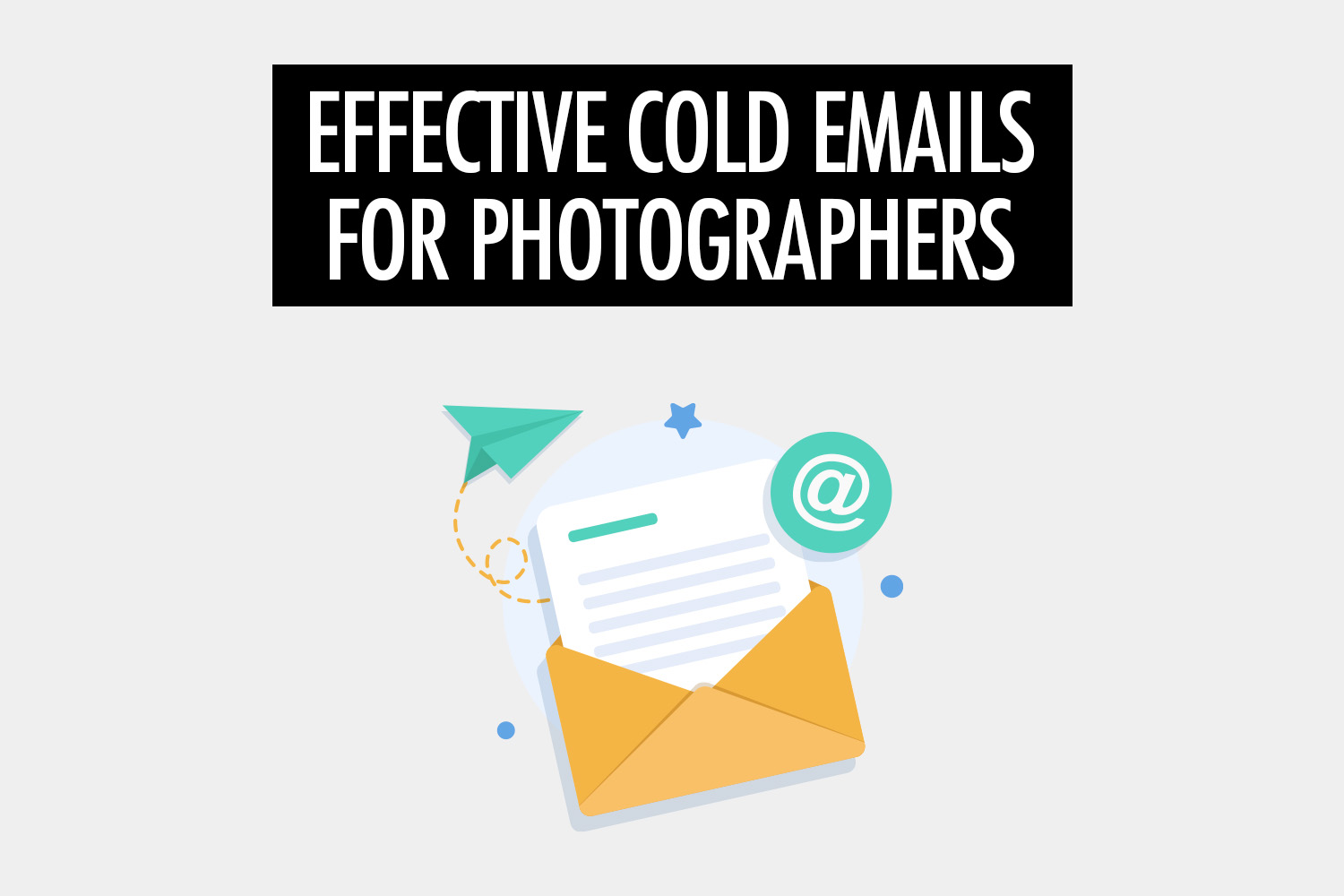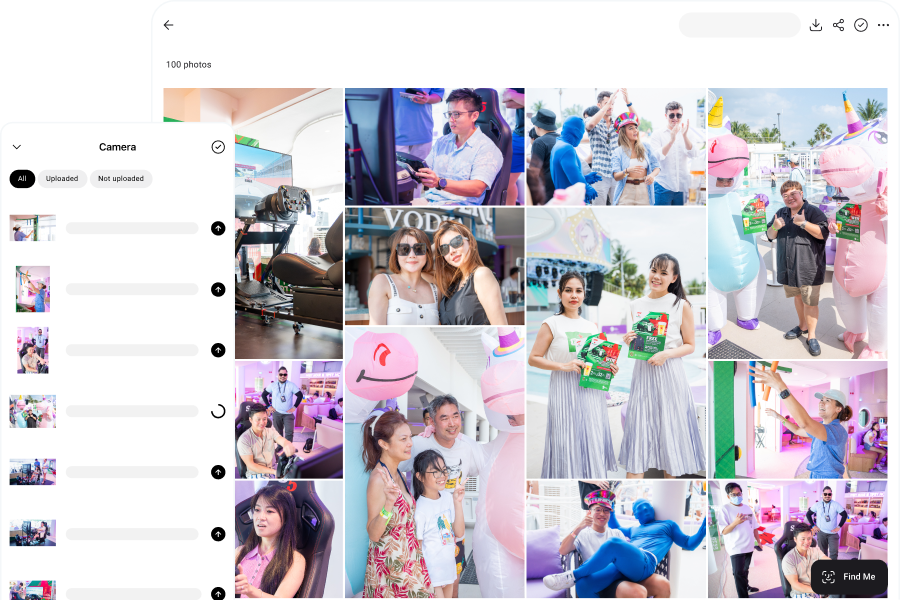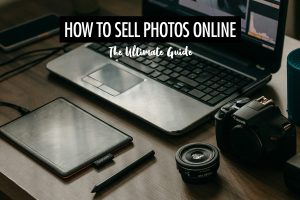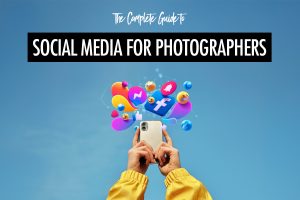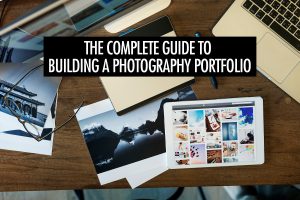Cold emails are one of the most powerful channels for getting leads and growing your photography business.
When done right, it can have a massive impact in helping you reach your ideal clients and close 5-figure deals—setting you on the path to financial success.
Unfortunately, most photographers (and businesses in general) do not understand how to do it properly.
It’s little surprise then, when they see no results from sending poorly-written and poorly-targeted emails that look like spam.
That’s going to change today, because I’m going to show you how to do the opposite. We’ll look at how to send effective cold emails that can double or triple your sales.
I’ve operated in 2 different industries—running a photography business and building a software company—and I see very different attitudes towards cold emails.
In the software space, it’s a well accepted channel—and many companies are open to experimenting with it.
In fact, there’s a large industry for companies that sell you the tools to send cold emails. For example, there are many tools to help you find email addresses, verify them, and automate the sending of emails.
Many of the largest software companies also have huge outbound teams that focus solely on cold outreach. We’re talking about household names like Salesforce and HubSpot, to fast growing companies like Deel.
In this article, I’ll show you the perfected tactics for sending cold emails and how I’ve applied them to grow my own photography business.
Who Should Send Cold Emails?
If you’re just starting your photography business, I strongly believe that you should try cold emails.
When I first started running my own photography and photo booth business in 2016, things were looking bleak.
We had a total of 4 bookings in our first 3 months, which was barely enough to keep the lights on.
It seemed like no matter what we tried, we would hit a brick wall. We tried Google Ads, social media, sponsoring events for free and setting up booths in local festivals—nothing was working.
That’s when we decided to give cold emails a shot.
Cold emails allowed us to reach out to our ideal clients, who were event planners at that time. It allowed us to have conversations to understand their pain points and how we could help them.
It’s no exaggeration to say that cold emails turned our business around. In our first 3 years, it helped us to double our sales every year.
In my opinion, cold emails are the best way to directly speak to and understand your clients, when you’re just starting out.
If you have been running your photography business for some time, I also believe that cold emails have a place in your marketing toolbox.
Even now, I still run cold email campaigns periodically, perhaps once a year.
It’s a great way to touch base with new prospects who might have recently entered the industry, as well as prospects we might have missed out in our previous campaigns.
What’s Holding You Back
Let’s address the elephant in the room—you think cold emails suck.
And I’d agree. Most cold emails do indeed suck.
They are poorly targeted and poorly written, so they look just like spam.
But the problem isn’t the channel. The problem is the execution.
We need to change the way we think about cold emails, and treat it as just another marketing channel—just like Google Ads or social media.
And just like Google Ads or social media, there is a path to mastering cold emails.
In this article, I’ll walk through the steps to send effective cold emails that are highly targeted and personalized, so that you can grow your leads and close more deals.
Let’s begin.
Step 1: Identify Your Target Market
The first step is to identify your target market.
This is something you have to be very clear about, because the surefire way to fail is by sending cold emails to everyone with a generic offer.
Let’s run through some examples.
If you’re a wedding photographer, you can’t exactly email all the couples in your area, in the hopes that they’re getting married.
What you need is a clearly identifiable target, so think about all the possible vendors that wedding couples might work with.
These might be wedding planners and venues (like hotels and restaurants), who are often on the lookout for reliable photographers to recommend. These might also be other non-competing vendors, like venue decorators, florists, and DJs.
In fact, many photo booth companies do not have in-house photographers, so there’s an opportunity for you to white label your services for them.
What about portrait photography? Again, the challenge is that you can’t email everyone, in the hopes that they just happen to need a portrait.
Think about the clearly identifiable targets.
You can reach out to the HR or marketing departments of companies—they might want nice portraits of their employees for their website, blog or social profiles.
Recruitment, real estate and insurance agencies are also potential targets, and can drive a high volume of referrals to you.
You’ll want to get creative and brainstorm potential targets, with the understanding that not every target market is going to work out in the end. That’s perfectly fine!
Step 2: Find The Right Email Addresses
Now that you have your list of target markets, it’s time to find the right email addresses to reach out to.
There are many approaches to finding email addresses. What I do not recommend is buying email lists—these tend to be low quality.
In general, you’ll want the email address of a specific person in the company (john@example.com), rather than the generic company email (hello@example.com).
That way, you can directly email the relevant person, rather than hope for someone in the company (probably an intern) to help you make the connection—which they have little incentive to do.
However, it also depends on the size of the company you’re reaching out to. If you’re reaching out to a 1 or 2 person company, it won’t make much of a difference.
But if you’re reaching out to a Fortune 500 company, that email is getting lost in the generic company email, 100% of the time.
The larger the company, the lower down the ladder I’d recommend reaching out to.
Hence, for small businesses, you can try heading right for the top person, like the CEO.
For bigger companies, you’d want to look for the appropriate department or job title, such as sales director or HR manager.
If you do not expect a large list of emails, it might make sense to find them manually. For example, you might want to reach out to wedding planners in your city, and you know that there are no more than 200 to 300 of them.
In that case, the most comprehensive and accurate approach is to search for them on Google—or any other platforms they might be listed on, such as wedding platforms.
What happens if you can only find the generic company email on their website, but you want to reach out to a particular person?
That’s when you’d want to cross-check on LinkedIn. Often, the company will have a list of employees and their job titles.
Now, what happens if you’re planning to create a large target list of more than 500 emails?
The manual process becomes very time consuming, and I’d recommend using the many available software tools that make this process a lot more efficient.
Most of these tools are built on LinkedIn’s database, and allow you to narrow down the results by filters like industry, department, job title and location.
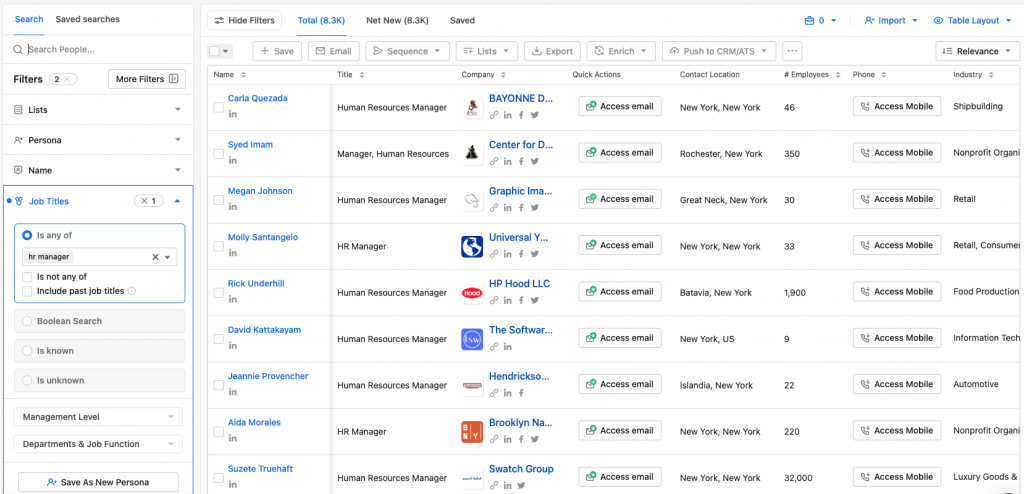
For example, if I search for HR managers based in New York on the Apollo platform, I’ll get 8,300 results. This list is way too large and I’d want to continue narrowing down my targets—for example, by selecting only smaller companies with less than 100 employees.
The last thing I want to do is to immediately blast out cold emails to 8,300 people, without first testing on a smaller group.
Step 3: Personalize the Email
So, we’ve identified the target market and found the right email addresses.
It’s time to craft an effective email that will get you past the first hurdle.
And the first hurdle is getting a reply. That’s all you’re looking for right now.
You’re not looking to close the deal or form a partnership from the first email. You’re just looking to start a conversation.
Personalization is the best way to improve open and reply rates. In a survey, 74.5% of respondents saw higher open rates when they used personalized subject lines for their cold emails.
Personalization can come from several things. At the basic level, you can personalize with the name and company.
Most people will do that with the email subject line and greeting. Here’s an example.
Subject: John – Are you looking for an event photographer?
Hi John,
Just wanted to reach out to introduce myself. I’m an event photographer based in New York, where you organize your conferences.
Do you happen to need any photographers in the upcoming months?
It’s a simple email that’s somewhat personalized, by mentioning the name and location—not too bad.
But if you do your research, you can take personalization a step further. Let’s look through some examples.
- Complimenting achievements: “Loved reading about your story on BizBash. It’s amazing how you’ve grown from $1m to $6m!”
- Complimenting experience: “Already been in business for 20 years? That’s really impressive in a competitive field!”
- Complimenting impressive clients: “Saw that you recently organized a large conference for Google. That’s a big deal!”
- Complimenting blog post or tweet: “Read your blog post about growing a strong company culture, great insights there!”
Obviously, more time and effort is required to personalize your emails. But again, if your strategy isn’t to blast your email to thousands of people, but rather to target just a few of your ideal clients, you’d want to make sure to increase your odds of success.
Step 4: Make an Irresistible Offer
So, you’ve caught your prospect’s attention by personalizing your email.
The next step is to make an offer they can’t refuse.
The best way to do that is by first understanding their pain points.
What are the most pressing issues they face in their own businesses—that keep them up at night?
This is where a deep understanding of your clients really matters.
The truth is, you’re probably not going to get your offer right the first time. And that’s perfectly fine.
Experiment with different angles and see what resonates with them.
Let’s run through an example.
Say you’re an event photographer, and you want to reach out to event planners to offer your services. What are some of the issues they could be facing?
Now, we know that many event planners have to pitch for contracts—where they compete with other planners to win the deal by presenting the best ideas.
That’s a highly stressful situation and they’re always looking for new ideas to maintain a competitive edge.
Hence, you’ll want to show how your service is unique, and can help them to create a compelling event experience.
One way is to work with Honcho, so that you can instantly share your event photos via face recognition or QR code.
It’s a unique selling point that massively improves the event experience for all of the guests.
Your email could look like this.
Hi John,
Love the workshops that you planned for Creative Mission, looks super interesting!
Have you thought about working with an event photographer who can instantly share the photos with your attendees? Because my service can do that with face recognition right away, so they don’t have to wait for days to get their photos.
Alternatively, you might want to reach out to event planners who organize large-scale events and require multiple photographers for coverage.
Event planners are incredibly busy with coordination work, and you can offer to take some of that load off their shoulders—by offering to manage multiple photographers yourself, so that you’re the only person they need to talk to for photography.
Here’s the good news. You only need to get your offer right once, and you’ll see your business take off rapidly.
So keep testing different offers to see what sticks.
Step 5: Keep It Short and Sweet
If you do a quick search online, you can find hundreds of cold email templates, all claiming to be the secret to high reply rates.
But the fact is, there isn’t a single template that can work for every industry or segment.
I’ve had cold emails that worked incredibly well for a segment of clients, that fell flat for a different segment.
That said, I do believe that there are certain best practices to follow.
And one of them is to keep your cold emails short.
We all know how short attention spans are now. Imagine opening a cold email from someone who you’ve never met before, and getting hit by a 300-word long email.
That email is going straight into the trash folder.
My personal rule of thumb is to keep my cold emails to 50 words or less. The examples that I’ve shared above meet that criteria.
It might not sound like much, and that’s exactly the point.
You have less than 5 seconds to get your prospect’s attention and convince them to give you more of their time.
You want to keep your message short.
Your cold email is not about you, so save the long introduction for another day.
Just talk about how you can help your prospect.
Remember, you’re not trying to close a deal. You’re just trying to start a conversation.
Step 6: Include a Clear Call to Action
You’ve personalized your email, made an irresistible offer and kept your email short and sweet.
Now, you want to make it clear what you actually want your prospect to do, and that comes from your call to action.
Are you just looking for a reply, or do you want them to book a call with you?
Personally, I’m not a fan of asking for a 15 or 30 minute call right off the bat, because it’s a significant commitment that you’re asking from your prospects.
That said, if you know that you have really nailed your offer, and it addresses a clear and urgent pain point, it can work wonderfully well. It has worked for me in specific situations.
Most of the time, I’m looking for a lower-friction action.
Let’s run through some example calls to action.
Mind if I send more info?
Can I share a PDF that explains how we do it?
Worth exploring?
Does this sound interesting to you?
Can I share some case studies of similar clients we’ve worked with?
Do you have time this Thursday for a quick chat?
Can I give you a call on Wednesday at 1pm?
Step 7: Always Follow Up
One common mistake is to send just one email, and to assume a lack of interest if there isn’t a reply.
Your offer can be the best thing your prospect has seen in months, and there’s still a chance they won’t reply.
They can be busy with work, something else can distract them, or they can plan to get back to you later but it slips their mind.
People are busy and there are other things they have to attend to.
That’s why you need to always follow up.
I don’t get the majority of replies with my first email. I get replies with my second, third and fourth emails.
If you don’t follow up, you can miss out on 70% to 80% of replies.
Hence, my sequences are usually made with 4 emails—each sent several days apart.
I’m not a fan of super long sequences that last for weeks or months. Beyond a certain point, you’re no longer providing any new information—you’re just repeating yourself in an annoying way.
When I design my sequences, I try to change up each email, so I can try different approaches and angles.
Let’s run through an example sequence.
- Initial email
- Quick bump
- Different angle
- Break-up email
Initial email
Hi John,
Love the workshops that you planned for Creative Mission, looks super interesting!
Have you thought about working with an event photographer who can instantly share the photos with your attendees? Because my service can do that with face recognition right away, so they don’t have to wait for days to get their photos.
Quick bump
Just wanted to check in on my last email. Worth exploring?
Different value angle
Wanted to share a couple of case studies, where we worked with similar event planners like you.
Do you work with multiple photographers to cover your larger events? Because we have several photographers on our team, and that can reduce your coordination work.
Do you need quick turnaround times? Because we’re known for delivering our edits within 3 days.
Break-up email
Here’s a quick summary of what we do. Just reach out if this ever becomes relevant to you.
Step 8: Track Your Results
I’ve said this before—you’re not going to get it right the first time, and that’s fine.
It just means that you need to keep testing different approaches, to see what works.
There are many variations you can test—different audiences, personalizations, offers and calls to action.
But in order to do proper testing, you need a way to get feedback.
That’s where tracking comes in.
There are many platforms that can help you to automate the sending of your emails, and to track their open, click and reply rates.
These metrics give you an idea of what’s working and what’s not.
For example, your open rate will give you an idea of how effective your email subject line is.
On the other hand, your reply rate indicates how effective your personalization and offer is.
To get a sense of how well you’re doing, look for reference statistics on the average open, click and reply rates for cold emails. Many of the same platforms have published these statistics for comparison.
To really finetune your emails, you want to constantly conduct A/B tests.
A/B testing just means that you’re comparing 2 versions of something, to figure out which performs better.
You want to change just one thing between the 2 versions, while keeping everything else the same. That way, if there’s a difference in performance, you know that it must be due to the one thing that you changed.
For example, you can change just the email subject line, while keeping the content the same.
If you see an improved open rate, it must mean that you found a better subject line.
As you adopt this mindset of experimenting, you build up your proficiency and develop an intuition for what works.
Over time, you’ll become a master of cold emails and have a powerful multiplier for growing your business, on demand.

